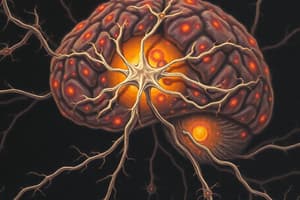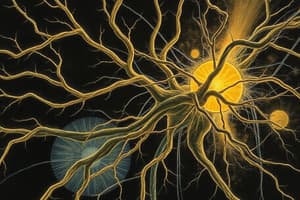Podcast
Questions and Answers
What role do astrocytes play in the nervous system?
What role do astrocytes play in the nervous system?
- They are responsible for insulating axons in the spinal cord.
- They create a scaffold for brain development and protect against toxins. (correct)
- They generate action potentials in motor neurons.
- They transmit sensory information from the body to the brain.
What is the primary function of microglial cells?
What is the primary function of microglial cells?
- Insulating neural axons to speed up transmission.
- Facilitating the transmission of electrical signals.
- Removing dead and dying neurons from the nervous system. (correct)
- Generating action potentials in response to stimuli.
What typically initiates an action potential in a neuron?
What typically initiates an action potential in a neuron?
- The binding of toxins to the neuron's membrane.
- The reception of enough excitatory signals to reach a threshold. (correct)
- A gradual increase in temperature within the neuron.
- The gradual accumulation of neurotransmitters in the synaptic cleft.
Which type of neuron carries information related to movement?
Which type of neuron carries information related to movement?
What is the effect of demyelination caused by conditions like Multiple Sclerosis (MS)?
What is the effect of demyelination caused by conditions like Multiple Sclerosis (MS)?
What happens during the rapid phase of an action potential?
What happens during the rapid phase of an action potential?
What defines the roles of interneurons in the nervous system?
What defines the roles of interneurons in the nervous system?
What consequence can result from ischemia in relation to neurons?
What consequence can result from ischemia in relation to neurons?
What is the primary role of the basal ganglia in the brain?
What is the primary role of the basal ganglia in the brain?
Which neurotransmitter is primarily associated with mood regulation?
Which neurotransmitter is primarily associated with mood regulation?
Which structure is primarily responsible for connecting the left and right hemispheres of the brain?
Which structure is primarily responsible for connecting the left and right hemispheres of the brain?
What role do descending tracts in the spinal cord primarily serve?
What role do descending tracts in the spinal cord primarily serve?
Which area of the brain is responsible for the production of dopamine?
Which area of the brain is responsible for the production of dopamine?
What type of memory is primarily associated with the hippocampus?
What type of memory is primarily associated with the hippocampus?
Which tract is responsible for transmitting touch information and joint stretch from the body to the brain?
Which tract is responsible for transmitting touch information and joint stretch from the body to the brain?
What is a potential consequence of imbalanced neurotransmitter levels?
What is a potential consequence of imbalanced neurotransmitter levels?
Which neurotransmitter is linked to cognitive arousal and attention?
Which neurotransmitter is linked to cognitive arousal and attention?
The gyrus and sulcus in the cerebral cortex are primarily characterized as what?
The gyrus and sulcus in the cerebral cortex are primarily characterized as what?
What is the function of the thalamus in the brain?
What is the function of the thalamus in the brain?
Which lobe of the cerebral cortex is primarily responsible for auditory processing and speech comprehension?
Which lobe of the cerebral cortex is primarily responsible for auditory processing and speech comprehension?
What effect do both hormones and neurotransmitter levels have on each other?
What effect do both hormones and neurotransmitter levels have on each other?
Which of the following best describes the significance of the ventricular system in the brain?
Which of the following best describes the significance of the ventricular system in the brain?
Flashcards are hidden until you start studying
Study Notes
Nervous System Cells
-
Glial cells: support and protect neurons
- Astrocytes: form the blood-brain barrier, protect brain from toxins, provide structure during development, aid in brain injury response
- Oligodendrocytes: insulate axons in the brain and spinal cord, promoting efficient signal transmission
- Microglia: remove cellular debris and pathogens, maintain brain health
- Schwann cells: similar to oligodendrocytes, but insulate axons outside the brain and spinal cord
-
Neurons: primary communication units of the nervous system
- Motor neurons: carry signals from the brain to muscles, controlling movement
- Sensory neurons: carry information from sensory organs to the brain, allowing us to experience the world
- Interneurons: connect neurons within the brain and spinal cord, responsible for complex processing and integration of information
Action Potential
- Neurons communicate through electrical signals called action potentials.
- Action potential is generated when a neuron reaches a certain threshold.
- This threshold is triggered by a chemical signal, causing the neuron to become more positively charged.
- Once triggered, an action potential occurs in an "all-or-none" manner, always at the same intensity.
- Increased signal strength is achieved by more frequent action potentials, not stronger ones.
Electron Transmission
- Action potentials travel along the axon, a long extension of a neuron.
- Myelin sheath, created by oligodendrocytes, insulates the axon, speeding up signal transmission.
- Nodes of Ranvier, gaps in the myelin, allow for signal regeneration.
- Degradation of myelin can disrupt nerve function, as seen in conditions like:
- Multiple Sclerosis (MS): progressive myelin breakdown, causing various symptoms like weakness, numbness, and cognitive impairment.
- Amyotrophic Lateral Sclerosis (ALS): neurodegenerative disease affecting motor neurons, leading to muscle weakness and paralysis.
- Ischemia: reduced blood flow to the brain, causing neuronal damage and potential death.
Chemical Transmission
- After electrical transmission, action potential reaches the axon terminal.
- Synapse: the junction between two neurons where chemical transmission occurs.
- Neurotransmitters: chemical messengers released by the presynaptic neuron into the synapse.
- Synaptic transmission steps:
- Calcium ions (Ca+) enter the terminal.
- Ca+ binds to vesicles containing neurotransmitters.
- Vesicles move to the end of the terminal.
- Neurotransmitters release into the synapse.
- Neurotransmitters bind to receptors on the postsynaptic neuron.
- Receptor binding triggers changes in postsynaptic neuron membrane potential (excitatory or inhibitory).
- Neurotransmitters are cleared from the synapse by reuptake or breakdown.
Neurochemicals
-
Dopamine:
- Production sites: substantia nigra and ventral tegmental area (VTA).
- Function: cognition, movement, reward and reinforcement learning.
- Dysfunctional levels linked to: Parkinson's disease, psychosis, and addiction.
-
Norepinephrine:
- Production site: locus coeruleus.
- Function: arousal, attention, memory, mood.
- Dysfunctional levels linked to: Alzheimer's disease, mood disorders, and visuospatial neglect.
-
Serotonin:
- Production site: Raphe nuclei.
- Function: mood regulation.
- Dysfunctional levels linked to: mood disorders and psychotic thought/behavior.
-
Acetylcholine (Ach):
- Production site: basal forebrain.
- Function: sensory processing, attention, learning, memory, and movement.
- Dysfunctional levels linked to: Alzheimer's disease and Myasthenia gravis (muscle weakness).
Challenges of Neurochemical Medication
- Individual baseline levels of neurotransmitters vary.
- Medications can have both positive and negative effects depending on individual differences in baseline levels.
- Interactions between neurotransmitters and other factors (e.g., hormones) can influence medication efficacy.
Spinal Cord
-
Descending tracts: pathways that carry signals from the brain down to the spinal cord.
- Corticospinal tract: primary pathway for voluntary motor control.
- Rubrospinal tract: motor control.
- Tectospinal tract: head and neck movements.
- Vestibulospinal tract: balance.
- Reticulospinal tract: muscle tone regulation.
-
Touch Information:
- Sensory information travels from the body to the brain.
- Two main pathways:
- Medial lemniscal tract: transmits touch and joint position information.
- Lateral spinothalamic tract: transmits temperature and pain information.
- Motor and sensory information are separated within the spinal cord, allowing for selective impairment of either system.
- The ventral side carries motor information, while the dorsal side carries sensory information.
Brain Anatomy
- Dermatomes: map of the body based on nerve innervation, important for understanding the distribution of sensory and motor function associated with specific spinal nerve segments.
- Gyrus: folds or bulges in the brain's outer layer (cortex).
- Sulcus: grooves or valleys in the brain's outer layer (cortex) that create distinct areas of the brain.
- Grey matter: unmyelinated parts of the brain containing cell bodies and dendrites, responsible for processing information.
- White matter: myelinated axons responsible for transmitting information throughout the brain.
Cerebral Lobes
- Frontal lobe: motor control, speech production, higher-order cognitive functions, personality.
- Parietal lobe: somatosensory cortex, processing touch information, spatial awareness, attention.
- Temporal lobe: auditory processing, language comprehension, memory.
- Occipital lobe: visual processing.
Sensory Processing
- Primary sensory areas: process only specific sensory information (e.g., primary visual cortex processes vision only).
- Secondary sensory areas: further refine processing of specific sensory information.
- Association cortex: integrates information from various sensory modalities, allowing for complex perception and understanding.
Brain Directional Terminology
- Superior/Dorsal: above.
- Inferior/Ventral: below.
- Anterior/Rostral: front.
- Posterior/Caudal: back.
- Medial: middle.
- Lateral: outside.
Brain Planes
- Sagittal: side view, cuts the brain vertically through the midline.
- Axial/Horizontal/Transverse: bird's-eye view, cuts the brain horizontally.
- Coronal: front-to-back view, cuts the brain vertically perpendicular to the sagittal plane.
Major Brain Structures
- Corpus callosum: connects the left and right hemispheres of the brain, facilitates communication across the hemispheres.
- Thalamus: sensory relay station, receives sensory input (except smell) and filters it before sending it to the cortex.
- Amygdala: involved in processing and experiencing emotions, especially fear.
- Hippocampus: essential for forming new memories.
Basal Ganglia
- Caudate nucleus, putamen, globus pallidus: key components of the basal ganglia.
- Functions: control of voluntary movement, learning of new motor skills.
- Dopamine is produced in the basal ganglia.
Cerebellum
- Functions: coordination of movement, motor learning, posture, balance, smooth muscle movements.
- Also plays a role in memory, language, and other higher cognitive functions.
Protecting the Brain
-
Ventricular system: a network of chambers in the brain filled with cerebrospinal fluid (CSF).
- Functions: buoyancy, protection, waste removal, nutrient delivery.
-
CSF is also present in the spinal cord; any disruption in CSF flow can affect both brain and spinal cord function.
-
Meningitis is an infection of the brain and spinal cord membranes that can cause serious complications.
-
Cerebral vasculature: the brain's blood supply, delivering vital oxygen and nutrients.
-
Circle of Willis: a network of arteries at the base of the brain that provides multiple pathways for blood flow.
- Anterior cerebral artery: supplies medial parts of the frontal and parietal lobes.
- Middle cerebral artery: supplies lateral surface of the cortex.
- Posterior cerebral artery: supplies occipital lobe and medial temporal lobe.
- Vertebral artery: contributes to the posterior circulation of the brain.
Studying That Suits You
Use AI to generate personalized quizzes and flashcards to suit your learning preferences.





